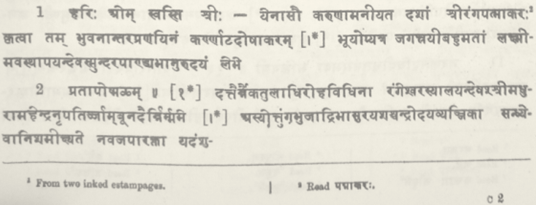|
The Indian Analyst
|
North Indian Inscriptions |
RANGANATHA INSCRIPTION OF SUNDARA-PANDYA. 1148. An inscription of the Poysaḷa king Vîra-Nârasiṁhadêva in the Raṅganâtha temple suggests that, subsequently to Śaka-Saṁvat 1194 (the date of No. V.), Râmanâtha was succeeded or supplanted by his half-brother Narasiṁha III. This inscription is dated in the cyclic year Vijaya, which would correspond to Śaka-Saṁvat 1216, and refers to Dêvaladêvî, who, as stated above, was the mother of Râmanâtha. ......The fact that Râmanâtha held Śrîraṅgam after the death of his father, suggests that the defeat which Sundara-Pâṇḍya inflicted on Sômêśvara, had no permanent effect, but that Râmanâtha soon recaptured Śrîraṅgam from the Pâṇḍya king. The subjoined inscription appears to have been engraved between Śaka-Saṁvat 1175, the date of the Bangalore Museum plates of Sômêśvara, and Śaka-Saṁvat 1179, the earliest date of Râmanâtha.
......The immediate purpose of the Raṅganâtha inscription of Sundara-Pâṇḍya is description of his building operations at, and gifts to, the temple. He built a shrine of Narasiṁha (verses 2 and 10) and another of Vishṇu’s attendant Vishvaksêna (verse 8), both of which were covered with gold, and a gilt tower which contained an image of Narasiṁha (7). Further, he covered the (original or center) shrine of the temple with gold,— an achievement of which he must have been specially proud, as he assumed, with reference to it, the surname Hêmâchchhâdanarâja, i.e. “the king who has covered (the temple) with gold,” and as he placed in the shrine a golden image of Vishṇu, which he called after his own new surname (3). He also covered the inner wall of the (central) shrine with gold (22) and built, in front of it, a dining-hall, which he equipped with golden vessels (23). In the course of two “dining-weeks,” which he called after his own name, he “filled the capacious belly” of the god, or rather of his votaries (26). In the month of Chaitra, he celebrated the “procession-festival” of the god (20). For the “festival of the god’s sporting with Lakshmî,” he built a golden ship (21). The last verse (30) of the inscription states that the king built three golden domes over the image of Hêmâchchhâdanarâja-Hari (compare verse 3), over that of Garuḍa (compare verse 16), and over the hall which contained the couch of Vishṇu (compare verse 6). ......The following miscellaneous gifts to Raṅganâtha are enumerated in the inscription :— A garland of emeralds (verse 4), a crown of jewels (5), a golden image of Śêsha (6), a golden arch (9), a pearl garland (11), a canopy of pearls (12), different kinds of golden fruits (13), a golden car (14), a golden trough (15), a golden image of Garuḍa (16), a golden under-garment (17), a golden aureola (18), a golden pedestal (19), ornaments of jewels (24), a golden armour (25), golden vessels (28), and a golden throne (29). The first of the gifts which are here enumerated, appears to have suggested the surname Marakata-pṛithivîbhṛit, i.e. “the emerald-king,” which is applied to Sundara-Pâṇḍya in verse 13. TEXT.1
| ||||||||||||||||||||||||||||||||||||||||||||||||||||||||||||||||||||||||||||
| > |
|
>
|








